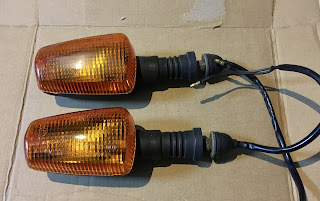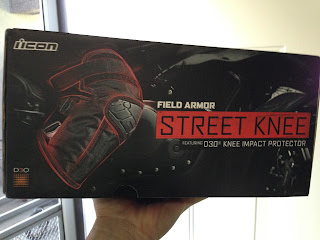Going OEM. Parts, parts and more parts.
Over the last week I have been collecting parts from my multiple Yahoo Auction purchases. I went on a bit of a buying spree after my search turned up many of the parts I had been on the look out for. Luck was on my side so I decided to make the buys. My auction experience has been positive every time I have made these purchases, but doing these transactions all in Japanese can be a bit nerve racking sometimes. Just like before, these worked out great and in short order I had several boxes in a pile waiting for me to open. This will be the first of three projects to make the XJR400R a bit more stock. Yes, I said make the bike more stock. I'll get to that in the post. Read on to hear more.
First stop was the easiest project. The weather has been up and down lately so I figured that I could knock out this project between rain showers and household chores. This box came pretty well packed and these OEM front turn signals were just as described and in great condition for their age. They are typical Yamaha turn signals. A bit large with a tendency to be floppy. I have been needing to do this project since I had to replace the rears when a wind storm knocked the bike over in my driveway. I went with OEM ones for the rear, but at the time couldn't find a matching set for the front at a reasonable price or in the right condition. Patience is the name of the game when stalking your auction prey and when these came up I pounced. For $25 including shipping they made it to my parts pile in a couple of days.Here are the front turn signals as they came with the bike. I mentioned in the intro that I have been wanting to get this bike back to stock for a while. The XJR400 series has been around from the early 90's to 2007. The are a pretty ubiquitous first "big bike" here in Japan. Yamaha came late to the air-cooled, four cylinder 400cc bike genre that was big in Japan in the late 80's and early 90's. Once they made it to the scene however, they quickly became a popular choice for people to move up a license class due to the very stable handling and engine character. Because of their popularity and overall low cost, they get modified and often as not get bit abused. This bike is no exception. Aside from the turn signals, the exhaust pipe, air cleaner, counter shaft sprocket cover and the carb jetting have been messed with. The front turn signals are some cheap, off brand, fake carbon fiber units you can find online. They didn't even match the rear signals which were a bit more tasteful. Riding in Japan requires a good attention span and lots of high vis gear. These winkers are just a bit too small for my taste. I want to be seen by my fellow road users so they had to go.
In theory I understand why the wiring harness meets in this mass of connections and multi-colored wire, but I still don't enjoy the thought of digging through this mess to work on things. Luckily enough the wiring seems to have escaped unscathed from the rest of the modifications on the bike. There are additions to the OEM wiring harness, but those are limited to a few accessories that are connected directly onto the battery. The front turn signals were very simply connected with individual sides to the handlebar switch's terminals with a common ground that is shared between the two. The wires and connections weren't dry rotted and the wiring was still flexible enough that they came apart with minimal fuss. I did one side first before doing the other to keep from mixing things up. I tested the signals and was happy to see that the bulbs were still good. A few more turns of the screwdriver and the headlight was back in the bucket and ready for a future ride.
Here you can see the size difference between what was on the bike and the OEM signals that were going to take their place. The fake carbon signals were not LED types and they used a much smaller incandescent bulb than the new-to-me old ones. The OEM signals are bigger in every dimension which should be good for visibility when making a turn. The roads in my part of Japan are tight, twisty and meet in an interesting variety of intersection shapes. As I mentioned earlier, being seen with good lighting and the liberal use of my highlighter yellow riding jacket has helped keep me from meeting the wrong end of one of my fellow road travelers. If there was one modification I could make, it would be too put in a dual filament bulb and rewire the lights so that they were on constantly in a dim setting like a set of running lights. When I used the controls to indicate a turn, they would flash from dim to bright. It would be even better if I could also incorporate LED bulbs into the overall mix. I know that there are some aftermarket lighting controls available and maybe this is possible.
More stock, more better. For me at least. I think the overall look of the stock signals is a better balance to the shapes the Yamaha designers integrated into the bike. There are lots square shapes with rounded engines that compliment the big slab of a four cylinder, inline engine. The styling is definitely from the 90's super bike era which is one of my favorites. The bike looks more evenly matched across the front and finally fits what is going on in the rear. I am very happy with the project and am glad I was finally able to get it done.
I still have a couple of other sets of parts that are waiting for me to have time to attach. As I type this I am halfway through the second of the three planned projects. That post should be out soon. The final project is a bit more in-depth and will most likely be covered in a series of posts. I still have the Cub to work on. I am still slowly removing the beige house paint. The Cub runs very well and has been a fun little commuter. Hopefully the state of the world lets you get out and ride. If you can, ride safe. See you next time!
Mat








Comments
Post a Comment
Thanks for your comments and for following My Motorbike Obsessions!